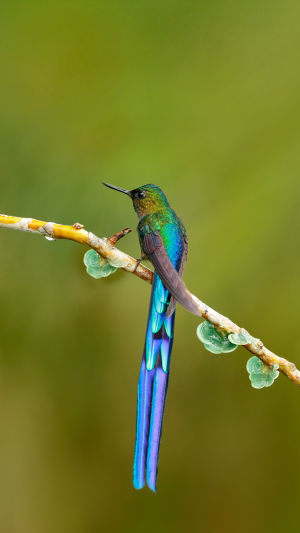Hummingbirds mostly live in Central and South America. Fossils of hummingbirds 1 million years ago have been found in South America, so scientists believe that hummingbirds originated from the Pleistocene.
However, scientists in southern Germany have discovered the world's oldest hummingbird fossil, which is more than 30 million years old. It can be seen that the ancestors of hummingbirds appeared as far back as the Oligocene.
The common ancestor of all recent modern hummingbirds is estimated to have inhabited some parts of South America 22.4 million years ago. This is a fairly recent family of modern birds, especially given the many species that are still alive, revealing that the birds experienced diversification at a rapid rate after reaching South America.
Genetic analysis shows that the diversity of hummingbirds continues to rise and grow today, with new species being created at a rate that exceeds the rate of extinction.
Hummingbird feathers are generally blue or green, with lighter underparts, and some males have crests or slender tail feathers. Among the males, the vast majority are blue-green, and some are purple, red or yellow.
Hummingbirds come in a wide variety of beak shapes, and beaks of different lengths and shapes are often a good indicator of the different flowers they eat. Hummingbirds have stretchable, forked tongues that facilitate nectar feeding. Hummingbirds are typically small-footed birds that cannot walk on the ground and change positions on their perches by flying rather than walking.
Here are some interesting facts about hummingbirds to share with you.
According to a report by The Dodo on March 23, 2018, the smallest bird in the world lives in Cuba. They are the smallest of the hummingbird species. Their English name is Bee Hummingbird, and from the name you can tell that they are small, maybe as big as some species of bees.
The male bee-sucking bird is about 5.7 cm long, but the tail and beak alone account for more than half of the length and weigh about 1.6 grams. Females are slightly larger. Their eggs are about the size of a coffee bean, and their nests may be a little bigger than a coin.
They can feed on the nectar of 1,500 flowers a day, can flap their wings up to 200 times per second (other hummingbirds have about 80), and can stay in the same position as a helicopter. Although they are small, the colors on their bodies are not sloppy at all. The feathers may be far more showy than many birds.
Because of their small size, their foraging competitors have long not included birds, but various insects. Male bee-suckers compete with (and protect) hawk moths and bumblebees for their favorite nectar, mosquitoes, and spiders.
The researchers speculate that they are so small because Cuba has another relatively large hummingbird, the kingfisher. The kingfisher hummingbird should be the first to come. After the branches and leaves were scattered here, the bee-sucking bird came to Cuba.
In order not to compete for food with the already entrenched kingfisher hummingbirds, they have evolved to become smaller and now compete only with insects.
However, there is a relative problem with their small size. They can fly longer than all other species of hummingbirds and have a very fast wing flapping speed, so their metabolism is very fast, and they must eat frequently. Otherwise, it is very easy Enter a deep lethargic state to keep energy expenditure to a minimum.
The giant hummingbird is 21.5 cm long, weighs 18.5–20.2 g, some birds may exceed 23 g, and is the largest member of the hummingbird family. The giant hummingbird has a shiny copper color with a gray-green back. It has a long, forked tail with a white throat.
Hummingbirds sometimes stray into garages and get trapped because they mistake hanging latch handles (usually red) for flowers, but sometimes hummingbirds get trapped in fences that don't contain any red. Once trapped inside, hummingbirds may not be able to escape, as their natural reaction is to fly upward when threatened or trapped. This is life-threatening for the hummingbirds, who die in a short period of time, possibly less than an hour, due to exhaustion. If a hummingbird is trapped, you can grab it and release it outside. When it is caught in the hand, it will remain silent until released.





